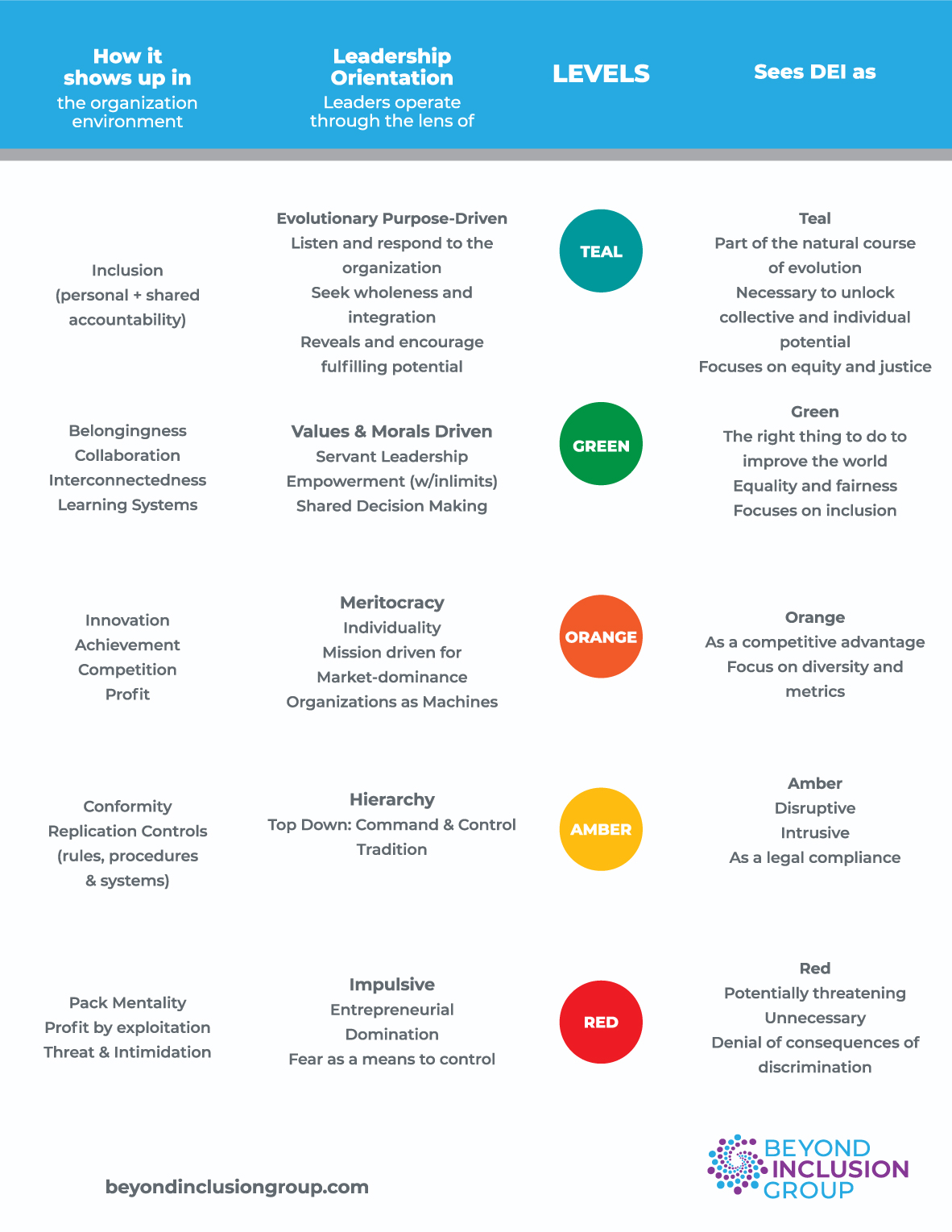Is your Leadership Lens Promoting or Preventing Inclusion?
At the end of the day, inclusion can only develop when leaders and their organizations evolve beyond “business as usual” and come to see that many common leadership ideals, status quo management models, and typical organizational practices are merely relics of the past.
Share This Post
Use Hindsight to Bring Inclusion into Focus
In today’s world, most organizations want to build equitable and inclusive workplace cultures where all team members can thrive. After all, by creating spaces where everyone feels valued, we improve creativity, enhance innovation, and boost financial outcomes. Yet even when the motivation to cultivate inclusion is strong, many organizations still fail!
Why?!?
The explanation for these common shortfalls–and the solutions for translating our intentions into transformative progress–lies with proper hindsight about how leadership approaches track with the evolution of human society across many millennia.
At the end of the day, inclusion can only develop when leaders and their organizations evolve beyond “business as usual” and come to see that many common leadership ideals, status quo management models, and typical organizational practices are merely relics of the past.
We Can Draw from Eons of Human Experience
In our last blog, we discussed how Evolutionary Purpose-Driven organizations encourage adaptation in socially and culturally diverse work groups and arrive at uniquely innovative solutions. This happens because each person is 100% invested in achieving great success, together. In other words, Evolutionary Purpose-Driven organizations attract and leverage diversity that generates belonging because their operating systems are designed and fueled by a truly inclusive DNA.
To help us appreciate this, let’s pause a moment and consider the leadership orientations that have preceded Evolutionary Purpose-Driven approaches.
According to historians, psychologists, and philosophers, human evolution happens by sudden leaps. In particular, noted human development authors Jenny Wade, Ken Wilber, Susanne Cook-Greuter, and Jean Gebser all find similarities in the major leaps and plateaus characterizing human history.
Each leap has directly influenced organizational models and leadership and management practices. The guide below shows the stages of human evolution and the parallels in organizational development. We have borrowed the color scheme that Ken Wilber originated to refer to each stage of evolution.
All organizations manifest characteristics of each level of development, but overall, they tend to operate at a particular level of development most of the time. This baseline level of typical functioning constitutes the organization’s center of gravity.
Our Ancestors Saw Red
The Impulsive (Red) worldview originated 10,000 years ago as swelling group sizes necessitated new human survival strategies. Prior to this stage, people lived in small, foraging clans led by elders without hierarchy or labor division. Due to the level of complexity associated with larger numbers of individuals living socially and beginning to develop collective resource innovations such as farming techniques, the concept of “the chief” emerged. Research points out that at this level of development, individuals operated in an impulsive and egocentric way so the need to enforce orders from the top became paramount for safety and survival. According to Frederic Laloux, author of Reinventing Organizations, in the Red worldview, everything is seen through the lens of power.
Red organizations are driven by a pack mentality and individuals are motivated by loyalty and fear inspired by the chief. Leaders in Red organizations operate and promote an “us versus them” mindset that sees differences as negative and alarming. At this level of development, diversity is not only seen as unnecessary but as a potential threat. Today this worldview is mainly found in organized crime factions, street gangs, and small enterprises where founders and bosses do whatever it takes to succeed.
Vestiges of this phase of evolution are well-known top-down power hierarchies and the concept of the division of labor. Thousands of years ago, these were major innovations that allowed groups to work together to deal with unprecedented levels of social complexity.
Amber Seized Control
Moving beyond the Impulsive (Red) Level, Hierarchical (Amber) is humanity’s first multi- layered approach to organizing. It originated about 5,000 years ago with the rise of agriculture from the Fertile Crescent (Mesopotamia) outward, especially to the Eurasian continent. It values status, order, conformity, laws, regulation, roles, discipline, morality, and self-sacrifice, and results in imperialism. Amber views the world and life as prescribed outcomes. The outcomes are solvable if you know the universal, ultimate truth. To get there, a person must follow some known rules and adhere to customs that have been ordained by an iconic authority.
The hallmarks of organizations that operate at the Amber level are the reliance on replicable processes and stable organizational charts. In this type of organization, templates are used and repeated year after year to achieve the same predictable results. People lack autonomy and are often locked in their roles and dissuaded from taking initiative.
Today this worldview is represented in government agencies, public school systems, universities, religious institutions, and military armed forces. Individuals at the top of these organizations are clear about their worldview and how right it is. As a consequence, these organizations often operate under the assumption that there is only one way to do things and anything counter to that worldview is perceived as threatening.
Through the Amber lens, diversity, equity, and inclusion tend to be seen as disruptive because developing initiatives to enhance them calls upon organizations to provide exceptions to the rules. Rules are the skeleton of Amber organizations, so questioning them is perceived as fatally radical.
The quest for inclusion in Amber organizations is foreign and unachievable due to the expectation of conformity driving the need for individuals to hide or change things about themselves in order to fit in. The price for inclusion is an unexamined demand for conformity, loyalty, and obedience.
In addition, the strict hierarchical structure of Amber organizations generates deep power differentials among leaders and subordinates. Individuals who are in the lower echelon are perceived as having less value and holding less power and influence. On the contrary, those who occupy leadership positions and have higher status are deemed superior and have more power. Therefore, decisions are often made by those at the top with little or no inclusion of those at the bottom.
Leaders at the Amber level of development identify with those with the similar taste attributes, beliefs, and expectations and tend to be threatened by differing demands, perspectives, diversity, and complexity. For this reason, organizations at the Amber level can lack diversity representation from certain social identities. To conclude, pursuit of DEI efforts in organizations operating at the Amber world view are usually motivated by legal compliance.
Evolutionary Leaps Will Carry Your Organization Forward
Stay tuned to learn more about the developmental levels and how a shift in them can make all the difference in your organization.

Read more Posts

Embracing Discomfort To Fuel Inclusive Leadership
“Speaking up does not require having all the answers. It requires courage, clarity of values, and a willingness to learn out loud.”

5 Signs Your Leadership Isn’t Evolutionary (and Why It Matters)
“Studies reveal that more than 40% of our behaviors are driven by fixed beliefs, habits, biases, and blind spots.”